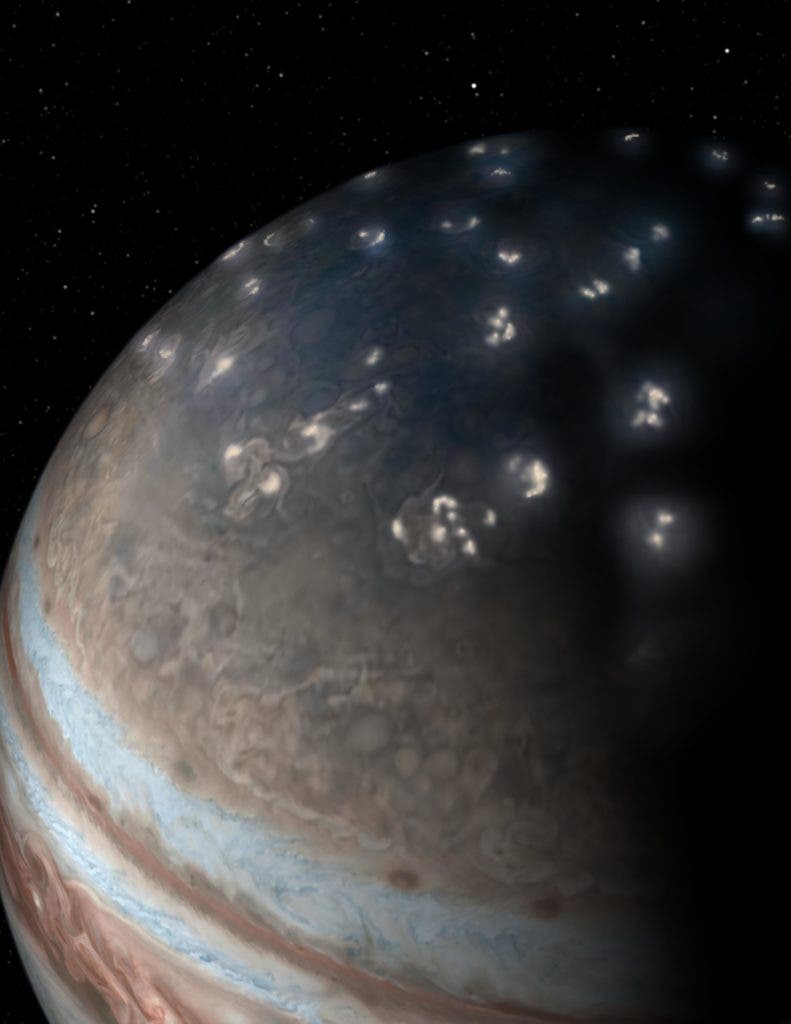Lightning bolts on Jupiter are both similar and completely different from those on Earth, research suggests.

Image credit:sNASA/JPL-Caltech/SwRI/JunoCam.
A new paper published by NASA’s Juno mission comes to flesh out our understanding of Jovian lightning. Their existence was first confirmed when the Voyager 1 craft flew past Jupiter in March 1979 — but that encounter also left us with more unanswered questions. Radio emissions produced by these lightning bolts didn’t match the signatures of those on Earth, for example.
God of Lightning
“No matter what planet you’re on, lightning bolts act like radio transmitters—sending out radio waves when they flash across a sky,” said lead author Shannon Brown of NASA’s Jet Propulsion Laboratory in Pasadena, California.
“But until Juno, all the lightning signals recorded by spacecraft were limited to either visual detections or from the kilohertz range of the radio spectrum, despite a search for signals in the megahertz range. Many theories were offered up to explain it, but no one theory could ever get traction as the answer.”
Fancy science-speak for ‘we didn’t have a clue what was up’. The Juno mission, however, gave researchers a chance to dig deeper into Jupiter’s lightning. The craft has been orbiting the gas giant since July 4, 2016. Among other onboard equipment, it boasted a Microwave Radiometer Instrument (MWR) to record emissions across a wide spectrum of frequencies
During its first eight flybys of Jupiter, Juno detected 377 lightning discharges, the team reports. Emissions were recorded in both the megahertz and gigahertz range, “which is what you can find with terrestrial lightning emissions,” according to Brown.
“We think the reason we are the only ones who can see it is because Juno is flying closer to the lighting than ever before, and we are searching at a radio frequency that passes easily through Jupiter’s ionosphere,” she adds.
These recordings show that lightning on Jupiter is very similar to that on Earth — but there are also differences.
Most striking of all is how these discharges are distributed across the planet’s surface. On Jupiter, these bolts of lightning flash frequently across the giant’s poles, but never over the equator. This doesn’t hold true on Earth. The reason behind this, the team believes, is how heat is distributed across the two planets.
The overwhelming majority of heat on Earth comes from the Sun. Our equator receives a much larger slice of this energy than the rest of the planet (that’s why it’s the hottest bit), meaning air masses above the equator have a lot of energy at their disposal to move around through convection. This movement is what fuels the thunderstorms which, in turn, produce lightning.
On Jupiter, however, sunlight is much, much dimmer. The giant is, after all, five times farther away from the Sun than Earth. This means the planet receives 25 times less heat than our planet. Most of the energy in Jupiter’s atmosphere is derived from its solid core. However, the team explains, that tiny quantity of heat it does receive from the Sun does heat up its equator more than the poles. The team believes that this difference in temperature is enough to stabilize Jupiter’s upper atmosphere around the equator, preventing gases further below to rise through convection.
The atmosphere around Jupiter’s poles, which receive less energy, isn’t stable — warm gases rising from below drive convection processes, creating lightning.
“These findings could help to improve our understanding of the composition, circulation and energy flows on Jupiter,” said Brown. But another question looms, she said. “Even though we see lightning near both poles, why is it mostly recorded at Jupiter’s north pole?”
The paper “Prevalent lightning sferics at 600 megahertz near Jupiter’s poles” has been published in the journal Nature.
Was this helpful?



